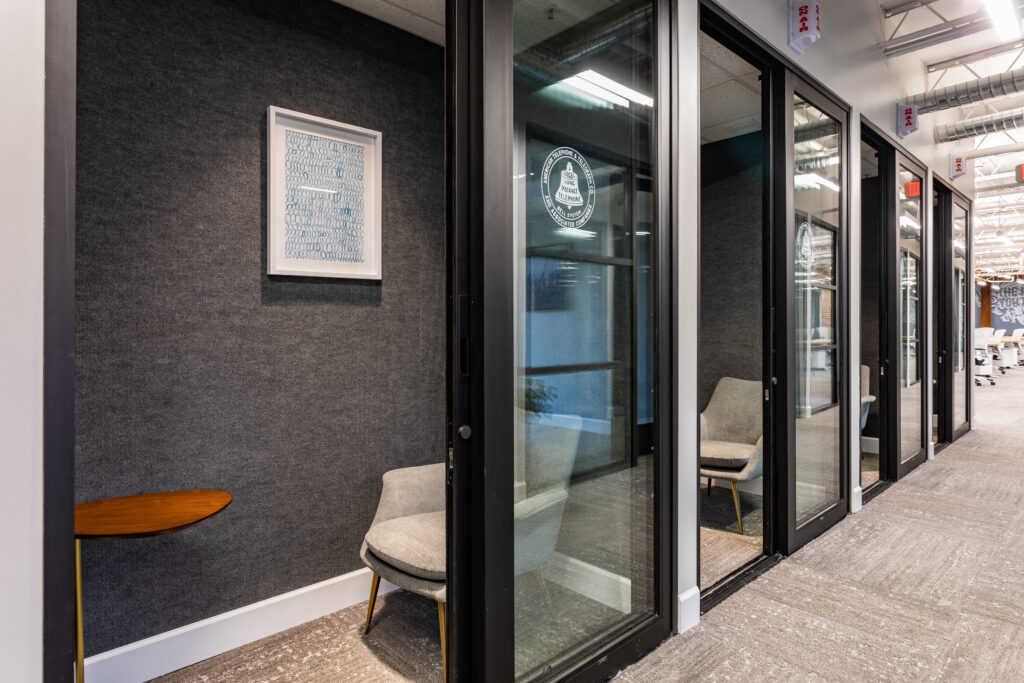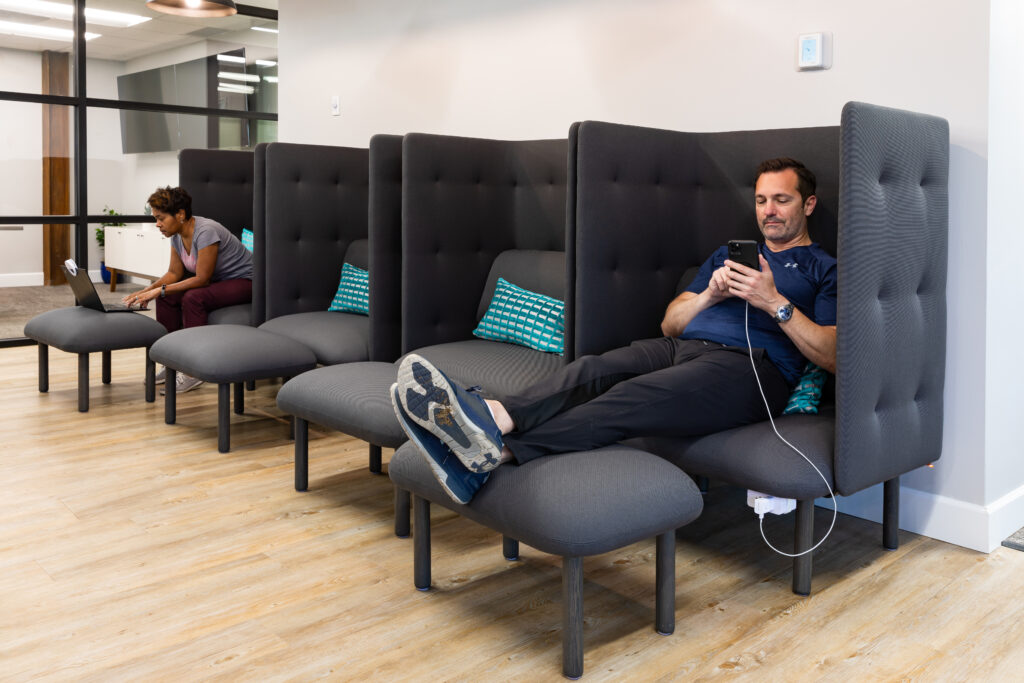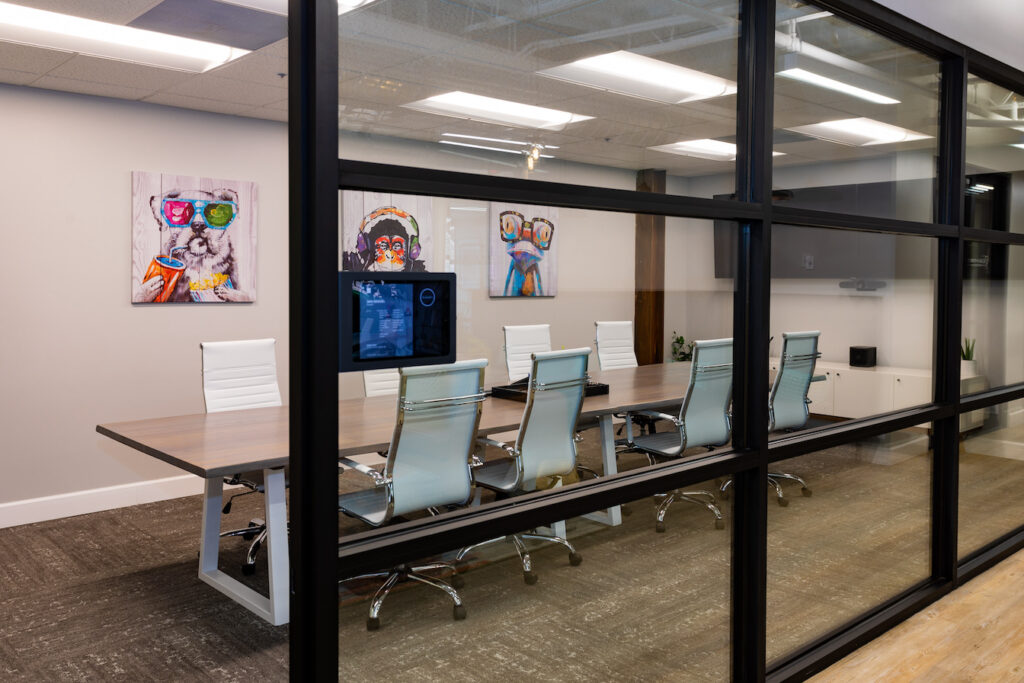
What comes to mind when thinking about a productive workspace?
Comfortable chairs, nearby outlets, the right temperature, natural light, and a nice cup of coffee—all factors that support focus and productivity.
But what about the acoustics of a workspace? Background noise, echoes, music for sound masking, and other features of the sound environment can have a significant impact on your ability to focus at work and achieve your goals.
Here we’ll explore the basic elements of office acoustics, why they matter for productivity, and how coworking spaces like The Post have ideal solutions to create an optimal environment.
Understanding Office Acoustics

Office acoustics is broader than whether there’s an upbeat playlist in the background or not. Instead, it references the ability to manage and control noise in a space to create the ideal work environment.
Noise is inevitable in shared environments. There is:
- Internal noise: This is noise generated in the workplace like continuous noises (i.e., ventilation sounds, air conditioning) or intermittent noises (i.e., beeping of a printer, people speaking).
- External noise: This is noise coming from outside the workplace and includes both continuous (i.e., traffic) and intermittent (i.e., trains or planes passing by) categories.
Open workspaces, including shared coworking spaces, are common today. Touted benefits include more collaboration, increased natural lighting, and a better use of space. But the reality is that open spaces mean more noise and sound pollution. Without the barriers of walls, there are more internal and external noises present in the workplace, which can hurt productivity in the workplace.
Controlling the noises and sounds in an office or workspace environment is done by understanding office acoustics and investing in the right infrastructure—more on that below.
Negative Impacts of Poor Sound Acoustics

Why is controlling noise and sounds so important in the workplace? There are two key reasons: productivity and privacy.
Productivity and Focus
We all have the experience of being in a concentrated flow state and getting interrupted by someone coughing loudly near us. Or, trying to focus on work, but the construction noise outside is just too loud.
Noise can impact productivity and keep professionals from focusing on their work at hand. Research backs this up, too. Studies show that:
- People can adapt to high-noise environments, but it causes fatigue and decreases working capacity and well-being.
- 69% of office workers report that noise negatively impacts their concentration levels, productivity, and creativity.
- Clerical workers in a noisy environment were less motivated to complete cognitive tasks.
- Noise can have negative health benefits, leading to oxidative stress, vascular dysfunction, and metabolic abnormalities.
Intermittent noises and sounds can be momentarily distracting, at best, but long-term exposure to noise pollution can have bigger impacts on health and well-being.
Privacy Concerns
The other reason controlling noise is important is for privacy reasons. Many professionals have phone or video meetings that contain confidential information that can’t be heard by other people.
Depending on the layout of your workspace or what you have access to, it may not always be possible to move to a different area. Effective office acoustics management can help ensure that sounds don’t carry or are masked well so that everyone can have private or confidential conversations.
The Coworking Solution to Poor Sound Environments

The solution to disruptive workplace sounds and noises is managing the office acoustics well. This is typically done by three main strategies:
- Absorb: Noise levels can be minimized by specific materials like ceiling tiles, carpeting, insulation, and even plants that help absorb disruptive noise. This can be used as an office-wide strategy and help with open, shared spaces.
- Block: This strategy selectively blocks out noise by creating sound-proof areas. This is typically used for small, enclosed spaces outfitted with sound-blocking materials.
- Cover: The last option is to mask sounds with another noise. This could be playing background music or white noise from an office-wide sound system. This levels out the overall office acoustics and covers up any distinct or distracting noises.
Any workspace needs to think about how they are effectively controlling sound and managing office acoustics in a way that optimizes productivity, focus, and privacy.
We’ve carefully engineered our atmosphere at The Post so it enhances your workday and offers a productive environment to do your best work. A big part of that is managing office acoustics—we do this by:
- Picking the right music: We mask background noise with an energizing—but not distracting—playlist. Check it out here!
- Soundproofing: To minimize sound transfer and noise pollution in our workspace, especially our private offices and meeting rooms, we’ve used specialized drywall, air vents, and other building materials, including ceiling paint, that specifically help insulate the space. This, along with our design choices, furniture, and plants, helps reduce echo and sound travel.
- Offering spatial diversity: Whether you have a private office, dedicated desk, or use the coworking area, you have choices! We set up The Post to offer spatial diversity so you can choose the best place to work. So, if you need to take a private phone call—use an insulated phone booth. Have a presentation? Book one of our sound-insulated meeting rooms. Looking to chat? Hang out in the lounge. This all helps minimize distracting noise as people choose the optimal work location.
In addition to choosing a workplace that prioritizes sound control and office acoustics, individuals can also be mindful of their sound environment. Using music or white noise to mask background noise, or removing yourself from a loud environment when you need to focus can be key for maintaining productivity.
Office acoustics and sound control may not be the first thing you think of when choosing a productive workplace. But the evidence is clear—noisy, distracting environments can harm productivity and focus which, along with privacy concerns, is detrimental to your work performance.
So, choose a workplace that manages office acoustics well. If you’re ready to elevate your professional experience and boost your daily productivity, book a tour of The Post today.
